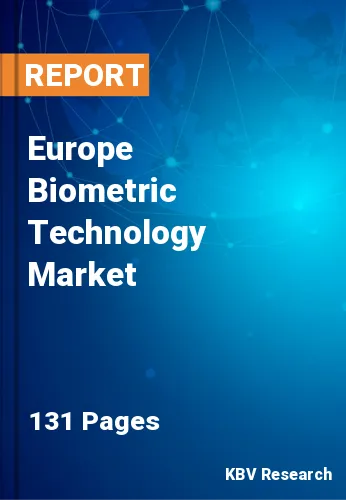The Europe Biometric Technology Market would witness market growth of 13.3% CAGR during the forecast period (2021-2027).
Biometric technology provides multiple benefits like increased level of security in the private, public, and commercial sectors. It has the ability to capture distinctive human characteristics, such as, retina, fingerprints, DNA and voice patterns for authentication purposes. Moreover, the market is gaining pace as a consequence of the rise in use of the technology in a variety of verticals and industries to improve security.
Three-dimensional face recognition is a comparatively novel trend which shatters the long-held tradition of copying the human visual recognition system, as 2D methods strive to achieve. Three-dimensional facial geometry reveals the detailed anatomical structure of the face instead of its external appearance which may be influenced by environmental factors. Thus, the 3D facial surface is unaffected by lighting, posture of the head and cosmetics unlike the 2D facial image.
Europe is a region which has shown significant interest and action in the adoption of biometric technologies. One of the reasons why biometric innovation has stayed consistent is the regular funding programs, such as, FFG KIRAS, EU PF7, IKT der Zukunft and H2020. A tight control of the border has, hence, remained a priority of many European nations and thus the usage of the biometric technologies to secure the border and erect contactless biometrics in automated border control gates. Thus, the usage of biometric technologies to put a halt to illegal immigration has gained traction. Contactless biometrics embedded in mobile devices has been used extensively in Europe to assist law enforcement agencies (LEAs) in performing their duties more efficiently.
The Germany market dominated the Europe Biometric Technology Market by Country 2020, and would continue to be a dominant market till 2027; thereby, achieving a market value of $5,621.2 million by 2027. The UK market is anticipated to grow at a CAGR of 12.4% during (2021 - 2027). Additionally, The France market would witness a CAGR of 14.2% during (2021 - 2027).
Based on Type, the market is segmented into Physiological Biometrics and Behavioral Biometrics. Based on Physiological Biometrics Type, the market is segmented into Face Recognition, Fingerprint Recognition, Iris Recognition, Hand Geometry, and Others. Based on Behavioral Biometrics Type, the market is segmented into Signature Recognition, Voice Recognition, and Others. Based on Component, the market is segmented into Hardware and Software. Based on End User, the market is segmented into Public Sector, BFSI, Healthcare, IT & Telecom, and Others. Based on countries, the market is segmented into Germany, UK, France, Russia, Spain, Italy, and Rest of Europe.
Free Valuable Insights: The Global Biometric Technology Market Size will Hit $85 Billion by 2027, at a CAGR of 14.1%
The market research report covers the analysis of key stake holders of the market. Key companies profiled in the report include NEC Corporation, Thales Group S.A., Fujitsu Limited, ImageWare Systems, Inc., Precise Biometrics AB, BIO-key International, Inc., Secunet Security Networks AG, Suprema, Inc., IDEMIA SAS, and HID Global Corporation.
By Type
By Component
By End User
By Country
Our team of dedicated experts can provide you with attractive expansion opportunities for your business.

